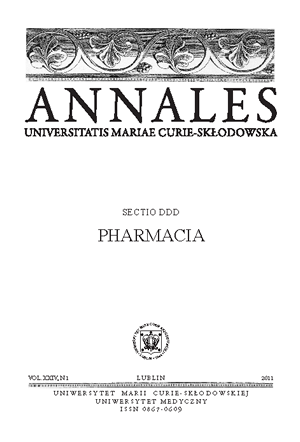Atorvastatin and ethyl alcohol as the inductors of apoptosis in cardiomyocytes in rats
Keywords:
Atorvastatin, apoptosis, Fas receptor, cardiac muscleAbstract
Atorvastatin belongs to statins which act by inhibiting 3-hydroxy-3-methylglutaryl-coenzyme A (HMG-CoA) reductase. Statins are the main substances which are used in the disturbed fat metabolism therapy, in the treatment and prevention the illness of cardiovascular system. Fas receptor belongs to superfamilies of TNF receptors and is one of the best known markers of the Extrinsic Pathway of apoptosis.
The aim of the work was estimate the expression of the Extrinsic Pathway apoptosis marker in cardiac muscle of rats after Atorvastatin and ethanol administration.
The experiment was carried on 30 female Wistar rats. They were divided into: 2 control groups (K and KA) and 4 experimental groups. During the study all animals were given standard granulated fodder and drinking water ad libitum. Moreover, the rats from all experimental groups were given Atorvastatin in 2 different doses independently from groups: 1.14 mg/kg of body mass and 11.4 mg/kg of body mass. The medicine was administered by successive 4 week periods in 1ml water suspension, once by day, by stomach tube. The rats from experimental groups 1 and 3 were given Atorvastatin and ethyl alcohol. The animals from all experimental groups were decapitated 24 hours following the last dose of the drug; next the heart samples for immunohistochemistry examination were taken. The Ethical Committee of the Medical University of Lublin gave consent to this experiment.
The strongest expression of Fas receptor was observed on the heart samples from experimental groups 1 and 3 which were given Atorvastatin and ethanol.
One of the advantageous pleiotropic statins actions is indication of apoptosis. The reader must be reminded that the strongest expression of investigated receptor was observed on the specimens from experimental groups 1 and 3 which were given Atorvastatin and ethanol. The obtained results may be connected with metabolism of ethyl alcohol. During this process free radicals may be formed. Additionally, the effect of consumption of great amount of ethanol may be oxidation stress. Reactive forms of oxygen and oxidation stress are the factors which can activate the Intrinsic Pathway of apoptosis. So the action of both substances which were used in experiment may stimulate the Extrinsic and the Intrinsic Pathway of apoptosis in the cardiac muscular tissue of rats.
References
1. Acharjee S., Welty F.K.: Atorvastatin and cardiovascular risk in the elderly–patient considerations. Clin. Interv. Aging., 3, 299, 2008.
2. Bartkowiak R., Janion M., Wożakowska-Kapłon B.: Plejotropowe mechanizmy działania statyn. Znaczenie w leczeniu chorób serca i naczyń. Via Medica, 6, 49, 2001.
3. Barzdo M. et al.: Ocena parametrów stresu oksydacyjnego w mózgach szczurów przewlekle intoksykowanych etanolem. Arch. Med. Sąd. Krym., LV, 134, 2005.
4. Bielak-Żmijewska A.: Mechanizmy oporności komórek nowotworowych na apoptozę. Kosmos Probl. Nauk Biol., 52, 157, 2003.
5. Bolaman Z. et al.: Effects of Atorvastatin on Coagulation Parameters and Homocysteine in Patients with Primary Hypercholesterolemia. J. Natl. Med. Assoc., 98, 1273, 2006.
6. Galus R. et al.: Pozalipidowe działanie statyn. Pol. Merk. Lek., XXIV, 144, 545, 2008.
7. Gąsior M. et al.: Plejotropowe działanie statyn. Choroby Serca i Naczyń, 5, 141, 2008.
8. Izdebska M. et al.: Molekularne aspekty procesów zachodzących w komórkach zarodków bydła podczas stresu cieplnego. Med. Wet., 63, 399, 2007.
9. Janion M.: Profilaktyka pierwotna chorób układu krążenia. Studia Medyczne Akademii Świętokrzyskiej, 3, 107, 2006.
10. Kapłon-Cieślicka A., Filipiak K.J.: Miejsce statyn w leczeniu zespołu metabolicznego. Choroby Serca i Naczyń, 5, 18, 2008.
11. Karpisek M. et al.: Treatment with atorvastatin reduces serum adipocyte-fatty acid binding protein value in patients with hyperlipidaemia. Eur. J. Clin. Invest., 37, 637, 2007.
12. Kubica A., Grześk G., Grąbczewska Z.: Choroby układu sercowo-naczyniowego – wyzwanie dla promocji zdrowia. Via Medica, Cardiovascular Forum, 11, 44, 2006.
13. Lusis A.J.: Atherosclerosis. Nature, 407, 233, 2000.
14. Łabędzka K., Grzanka A., Izdebska M.: Mitochondrium a śmierć komórki. Postępy Hig Med. Dosw. (online), 60, 439, 2006.
15. Mamcarz A., Podolec P., Kopeć G.: Alkohol a choroby układu sercowo-naczyniowego. Forum Profilaktyki, 1, 1, 2006.
16. Michalak J.M. et al.: Atorwastatyna – czy najskuteczniejsza statyna w kardiologii? Studia Medyczne, 12, 61, 2008.
17. Uznańska B., Plewka M.: Rewizja wytycznych dotyczących leczenia zaburzeń lipidowych wysokiego ryzyka u dzieci i młodzieży-najnowsze stanowisko The American Heart Association. Via Medica, Cardiovascular Forum, 12, 32, 2007.
Downloads
Published
Issue
Section
License
Copyright (c) 2011 Authors

This work is licensed under a Creative Commons Attribution-NonCommercial-NoDerivatives 3.0 Unported License.


